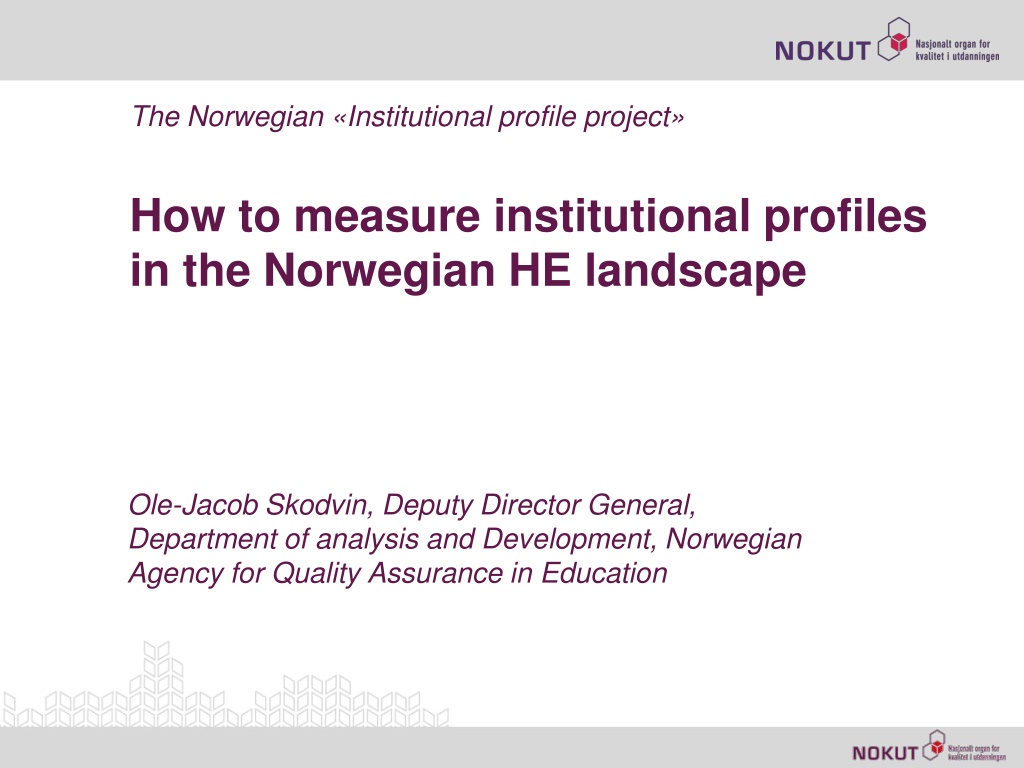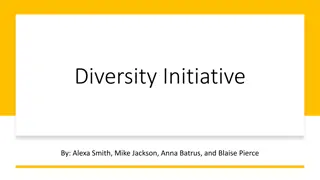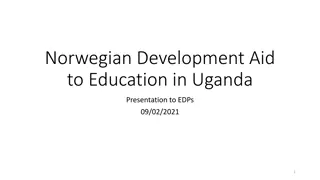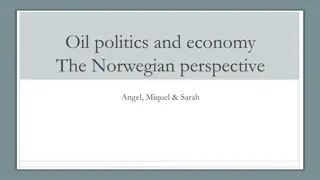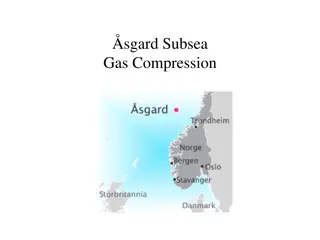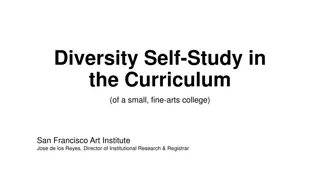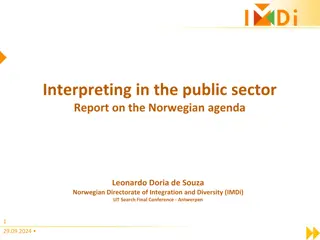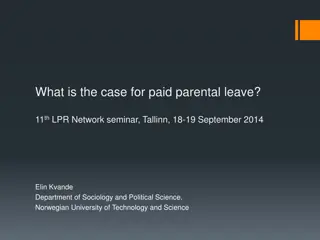Understanding Diversity in the Norwegian Higher Education Landscape
Exploring the concept of institutional diversity in the Norwegian higher education system, this project delves into measuring institutional profiles, the significance of diversity, why it is perceived as positive, and the factors influencing diversity control. Through insights from experts like Ole-Jacob Skodvin, Deputy Director General at the Norwegian Agency for Quality Assurance in Education, this project provides a comprehensive look at the role of diversified higher education systems and the benefits they bring to society and students.
Download Presentation

Please find below an Image/Link to download the presentation.
The content on the website is provided AS IS for your information and personal use only. It may not be sold, licensed, or shared on other websites without obtaining consent from the author. Download presentation by click this link. If you encounter any issues during the download, it is possible that the publisher has removed the file from their server.
E N D
Presentation Transcript
The Norwegian Institutional profile project How to measure institutional profiles in the Norwegian HE landscape Ole-Jacob Skodvin, Deputy Director General, Department of analysis and Development, Norwegian Agency for Quality Assurance in Education
Diversified higher education systems? All countries have an intention or a political goal of having a diverse higher education system Institutions with different profiles, end products etc. In principle, a clear division of labor and specialization among the different types of institution - in sum, they provide what society needs in education, research, dissemination and innovation
What do we mean by institutional diversity? A classification on forms of differentiation and diversity Forms Object of study External diversity (system level) Classification, typology, comparison of institutions Internal diversity and differentiation (program level) Differentiation of roles and functions Classification, typology, comparison of disciplines/programmes Differentiation (development, change) of functions, roles and structures
Why is diversity perceived as positive? Diversity is seen as positive because it is expected: To increase students options (meet students needs and leading to increased social mobility) increases the overall efficiency of the higher education system: It opens up higher education for the community It facilitates and maintains specialization within the system It meets the demands of an increasingly complex society and labor marked 18.09.2024 | 4
Why is diversity perceived as positive? Provides opportunity to use different organizational models Protects institutional autonomy Allows both an elite education and a mass education Provides for division of labor and specialization in relation to research and development Paves the way for reforms through institutional competition
What controls diversity? State control versus market Public authorities' management of higher education: Using the metaphor "Gardener Care for and maintain diversity - (and weed out unwanted weeds )
Different higher educational models A diversified and multipurpose system USA and Canada A binary system (A University sector and a specialized college sector vocationally oriented Germany, Austria, Switzerland, the Netherlands and Finland A unified system UK and Australia:All institutions have the university name, however they are in different "divisions" - clear status differences between the institutions A transparent binary system with opportunities for " advancement (but not degradation / relegation ) Norway and Sweden
The contours of a new education landscape? Higher education is characterized by increased competition for students nationally and internationally Research is changing in the direction of larger academic communities - where the intention is higher quality The interdisciplinary and multidisciplinary approach increases The international competition for research funding and talent increases Several countries are establishing elite universities
Higher education in change in the Nordic countries Higher Education is linked to economy the value creation perspective Global competition for talent Consequence: The HEIs seek to concentrate their academic, economic/-administrative resources into larger and more competitive units Cultivates the formation of elite institutions USA and UK have had such institutions for a long time several countries are now following this trend The German excellence initiative with selected lighthouses France the authorities have signaled a major effort to build up new elite institutions
Norway In the international context the Norwegian University College sector is unique: No other country spends so much time and resources on R&D in their vocationally oriented higher education sector There is a huge drift in the University College sector to reach university status The Norwegian HEIs are regulated by the same law, have a common job position structure, a joint reward and career system and common academic norms and values Are we going in the direction of getting pale copies of the original? Should all institutions be allowed to call themselves universities? The point is not what they're called - but what they actually do - or .?
Norway (II) Outline of a new HE landscape in Norway Several voluntary cooperation alliances and mergers HEIs want to enhance their position in the regional, national and/or international HE market The Ministry supports cooperation, specialization, concentration and division of labor Rhetorical level: Stimulate quality along different axes in a diversified HE-system | 11
How to measure diversity? As part of Result oriented Planning - the Ministry of Education and Research annually conducts an individual consultative steering dialogue meeting with each public HEI Can be seen as an instrument to secure a diversified HE- sector in Norway Measure diversity by different performance indicators but in addition try to classify the HEIs institutional profiles Developed a tool to describe the diversity in the Norwegian HE-sector The flower project | 13
Classification of higher education institutions Institutional profiles Based on the EU classification project - U-Map Important in order to: Visualize the HEIs' profiles and unique purposes Support quality cultures along different axes Strengthen the HEIs capabilities to formulate clear objectives and strategies To show the HEIs profiles and purposes to the outside world Facilitate comparison between similar HEIs (difficult with the current ranking system) Can be developed to be a useful input in the Ministry's management and steering of the higher education sector
Classification of higher education institutions Institutional profiles Norway is in a unique position though the national database for statistics on higher education (DBH) Statistical information on the institutional level is reported from all the HEIs to DBH All the dimensions and most of the indicators in the U-Map project, are covered in our national public statistics This gives the Ministry a possibility to develop a somewhat simplified and modified version of the U-Map project based on statistical register data
Classification of higher education institutions Institutional profiles These are indicators that are part of the national funding system, performance indicators that are reported to the Ministry, and other quality assured indicators The project has been named "Flower" - and shows roughly the institutional profiles we have in the Norwegian higher education system Check out DBH s website: http://dbh.nsd.uib.no
An overview of dimensions and indicators in the Flower Size Education Research Vocationally oriented profile Master students Continuing and further education students Student credit points production The students age profile Part-time students Student popularity (number of qualified applicants) Size of institution (measured in number of students) Academic staff profile (share of associate professors and professors) Doctoral degree production) Academic publication (extent of publication points) Research funds from EU and NRC (Norwegian Research Council) Internationalization Relations with society Economics and Resource Management Implementation of the budget (Write-off) Allowance (Provisions as a percentage of revenue) Commission contract work Liquidity Exchange students (per registered students in total) Contributions to activities outside the EU and NCR Contract work (as percentage of total expenditure) Business ideas
18.09.2024 | 18
18.09.2024 | 19
18.09.2024 | 20
18.09.2024 | 21
18.09.2024 | 22
18.09.2024 | 23
18.09.2024 | 24
18.09.2024 | 25
18.09.2024 | 26
18.09.2024 | 27
18.09.2024 | 28
18.09.2024 | 29
18.09.2024 | 30
